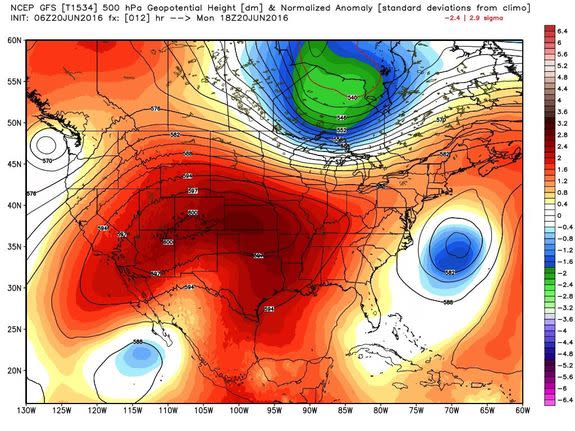Deadly heat wave scorches Southwest, expands its reach this week

According to the calendar, Monday is the first day of summer. For millions of people in the Southwest, from Phoenix to Los Angeles, the extreme heat today will make it feel more like mid-July.
High temperatures are forecast to reach nearly 120 degrees Fahrenheit in the Phoenix area, after hitting 118 degrees on Sunday. The 118-degree high temperature was the fifth-warmest day on record there, and if the city were to see a 120-degree high temperature on Monday, it would be only the fourth time such a heat record were reached.
SEE ALSO: Earth's hot streak continues with warmest May since at least 1880
The all-time high temperature record for Phoenix is 122 degrees Fahrenheit, set in 1990.
High temperatures in the desert areas of Arizona, Nevada and interior southern California are likely to eclipse 120 degrees Fahrenheit on Monday, with a high of nearly 100 degrees possible even in downtown Los Angeles and Burbank, California. Burbank hit 105 degrees on Sunday, which was a daily high temperature record.
Tuscon's high temperature of 115 degrees on Sunday tied that city's third-warmest temperature on record.
More daily high temperature records, and possibly some all-time high temperature records, are likely to be broken on Monday in Las Vegas, Phoenix, Needles, California, and Kingman, Arizona, among other locations.
The heat is helping to fuel an outbreak of wildfires across several states, including drought-parched California, but this heat wave is not accompanied by high winds, which is lowering wildfire risks somewhat, the National Weather Service (NWS) said.
Excessive heat warnings are in effect for parts of Arizona, New Mexico, Nevada and California, given the health risks that such conditions pose.
Heat of this magnitude can be deadly, particularly for the elderly, small children or those with preexisting medical conditions. It can also make working outside downright perilous. Two people in Arizona have already died of heat-related illnesses.
Air travel delays possible on Monday
If temperatures at the major airports in the Southwest reach the mid-100s, there is the possibility of travel delays since such heat can make aircraft components unreliable. It can also cause problems for departing aircraft by reducing the ability of a plane's ability to achieve sufficient lift while barreling down a runway.

Image: The Arizona Republic, Tom Tingle/AP
This occurs because hot air is far less dense than cold air is, and extreme heat plus high elevations can put some aircraft types beyond their certification limits.
The NWS in Las Vegas mentioned this possibility in an aviation forecast discussion posted on its website on Monday morning (McCarran is the name of Las Vegas' main commercial airport):
Unusually intense high pressure area
An extremely intense, sprawling area of high pressure is causing the heat wave. Also known as a "heat dome," the high pressure area is sitting on top of the Southwest and pumping extremely hot, relatively dry air northward from Mexico, while encouraging the air to sink, thereby stifling any widespread rain showers and thunderstorms. Meteorologists often look to a metric known as geopotential height anomalies to gauge the intensity or unusualness of a heat dome like this. Geopotential height measures the elevation of an air pressure surface. Hot air masses expand, and elevate pressure surfaces, while cold air masses are more dense and compact, thereby lowering them. The 500-millibar geopotential height for this heat event is beyond the normal range on the high end, according to numerous computer model simulations. According to the NWS office in Phoenix, the 500-millibar heights, along with air temperatures in the lower layers of the atmosphere, are "near record levels." Such intense heat domes are becoming more frequent occurrences in the Southwest and other parts of the world, which is possibly related to global warming. This heat dome will weaken somewhat by midweek, but it's not forecast to disappear entirely during the next one to two weeks. In fact, unusual heat is forecast to spread northwestward, into the Pacific Northwest, by early next week. In addition, parts of the Plains and southern tier of the U.S. could also see hotter conditions as a result of this sprawling high pressure area. If this heat dome becomes a semi-permanent feature of the 2016 North American summer weather pattern, it could make for an extremely miserable season for tens of millions of Americans. It could also exacerbate already high wildfire risks and help to dry out California even further, erasing any moisture gains made during the fickle El Niño winter. For now, at least, some residents of the Southwest are taking the heat in stride. Kim Leeds, 28, told the Associated Press that she decided to experiment with the heat, after living in Phoenix for three previous summers.

Weather pattern to overstay its welcome
"I'm totally reveling in this experience because I'm actually baking cookies in my car," Leeds said. "I've been here long enough that I've got to do these things."
